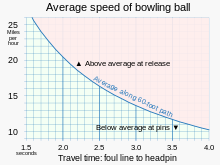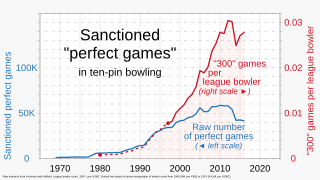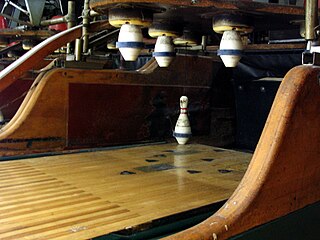- This glossary relates mainly to terms applicable to ten-pin bowling. For candlepin terms, see Candlepin bowling#Terminology.






















| Dinner bucket Bucket if missing 8-pin | Double wood left or Sleeper #1 | Double wood right or Sleeper #2 |
|---|---|---|
| 7 8 9 10 4 5 6 2 3 1 | 7 8 9 10 4 5 6 2 3 1 | 7 8 9 10 4 5 6 2 3 1 |
| Baby split | Christmas tree #1 | Christmas tree #2 |
| 7 8 9 10 4 5 6 2 3 1 | 7 8 9 10 4 5 6 2 3 1 | 7 8 9 10 4 5 6 2 3 1 |
| Big Four | Greek Church (Big Five) | Goal (Fence- or Bed-) posts |
| 7 8 9 10 4 5 6 2 3 1 | 7 8 9 10 4 5 6 2 3 1 | 7 8 9 10 4 5 6 2 3 1 |
| Dime store #1 | Dime store #2 | Lily, Sour apple |
| 7 8 9 10 4 5 6 2 3 1 | 7 8 9 10 4 5 6 2 3 1 | 7 8 9 10 4 5 6 2 3 1 |
| Washout #1 | Washout #2 | Modern Washout (Super Washout) |
| 7 8 9 10 4 5 6 2 3 1 | 7 8 9 10 4 5 6 2 3 1 | 7 8 9 10 4 5 6 2 3 1 |









Five-pin bowling is a bowling variant which is played in Canada, where many bowling alleys offer it, either alone or in combination with ten-pin bowling. It was devised around 1909 by Thomas F. Ryan in Toronto, Ontario, at his Toronto Bowling Club, in response to customers who complained that the ten-pin game was too strenuous. He cut five tenpins down to about 75% of their size, and used hand-sized hard rubber balls, thus inventing the original version of five-pin bowling.

Ten-pin bowling is a type of bowling in which a bowler rolls a bowling ball down a wood or synthetic lane toward ten pins positioned evenly in four rows in an equilateral triangle. The objective is to knock down all ten pins on the first roll of the ball, or failing that, on the second roll. People approach modern ten-pin bowling as either a demanding precision sport or as a simple recreational pastime.

Candlepin bowling is a variation of bowling that is played primarily in the Canadian Maritime provinces and the New England region of the United States. It is played with a handheld-sized ball and tall, narrow pins that resemble candles, hence the name.

A bowling alley is a facility where the sport of bowling is played. It can be a dedicated facility or part of another, such as a clubhouse or dwelling house.

Duckpin bowling is a variation of the sport of bowling.

A bowling ball is a hard spherical ball used to knock down bowling pins in the sport of bowling.

A perfect game is the highest score possible in a game of bowling, achieved by scoring a strike with every throw. In bowling games that use 10 pins, such as ten-pin bowling, candlepin bowling, and duckpin bowling, the highest possible score is 300, achieved by bowling 12 strikes in a row in a traditional single game: one strike in each of the first nine frames, and three more in the tenth frame.

In bowling, a pinsetter or pinspotter is an automated mechanical device that sets bowling pins back in their original positions, returns bowling balls to the front of the alley, and clears fallen pins on the pin deck. Prior to the machine's invention, pinsetters were boys or young men hired at bowling alleys to manually reset pins and returned balls to the player. The first mechanical pinsetter was invented by Gottfried (Fred) Schmidt, who sold the patent in 1941 to AMF. Pinsetting machines have largely done away with pinsetting as a manual profession, although a small number of bowling alleys still uses human pinsetters. While humans usually no longer set the pins, a pinchaser is often stationed near the equipment to ensure it is clean and working properly, and to clear minor jams.

Chris Barnes is an American professional bowler and member of the Professional Bowlers Association (PBA), who currently competes on both the PBA Tour and PBA50 Tour. He has also competed internationally as a member of Team USA.
In the sport of ten-pin bowling, there are many different ways in which to deliver the bowling ball in order to advance it toward the pins in an accurate and powerful manner. Generally, there are three basic forms of 10-pin bowling. The most basic form is known as stroking, which is the most classic form. The most powerful form is known as cranking, which imparts great leverage and maximum rotation on the ball, but sacrifices accuracy. In between the two is the domain of the tweener, who has characteristics of both, but does not truly fit into either category. A well-known variant of "tweening" is the power stroker.

In bowling, a strike means that all of the pins have been knocked down on the first ball roll of a frame. On a bowling scoresheet, a strike is marked by an "X".
Don Johnson was born in Kokomo, Indiana, but spent most of his adult life in Akron, Ohio and Las Vegas, Nevada.

Nine-pin bowling is a bowling game played primarily in Europe. European championships are held each year. In Europe overall, there are some 130,000 players. Nine-pin bowling lanes are mostly found in Austria, Czech Republic, Slovakia, Belgium, Germany, Luxembourg, the Netherlands, Estonia, Switzerland, Serbia, Slovenia, Croatia, Poland, North Macedonia, Hungary, France, Brazil and Liechtenstein.
A 900 series refers to three consecutive perfect games bowled by an individual bowler. A 300 is a perfect score in one game, thus a player's maximum possible score would be 900 in a series of three consecutive games. To achieve the feat, a bowler would have to bowl 36 consecutive strikes.

A hook in ten-pin bowling is a ball that rolls in a curving pattern. The purpose of the hook is to give the ball a better angle at the 1-3 pocket (right-handers) or 1-2 pocket (left-handers.) to achieve a strike. When a ball is rolled straight, hitting the pocket must be precise. By hooking the ball, the ball will hit the pins with more force, producing better carry - especially on the 5-pin during a strike ball. Straight roll - even when it hits the pocket, will tend to leave a tap such as the 5-pin on a light hit, or the 10-pin if the ball was just slightly right of center pocket or with inadequate entry angle. A hook ball can achieve strikes with less precise hits.

Bowling is a target sport and recreational activity in which a player rolls a ball toward pins or another target. The term bowling usually refers to pin bowling, though in the United Kingdom and Commonwealth countries, bowling could also refer to target bowling, such as lawn bowls.
Sport Bowling is any form of ten pin bowling that uses patterns of lane oil to reduce the effectiveness of modern bowling balls. It was created by the United States Bowling Congress, the governing body of the sport of ten-pin bowling, to offer players the opportunity to bowl on exactly the same lane conditions and oil patterns that professional bowlers face while on the PBA Tour. Sport Bowling originally referred to leagues, known as PBA Experience Leagues, which are offered in conjunction with the Professional Bowlers Association. However, the term is now used to refer to any bowling event which incorporates a "sport shot" or oil pattern.
The World Bowling Tour, a major professional tour, unites bowlers from selected major professional and amateur organizations through a series of events organized by World Bowling.

Anthony Walter Simonsen is an American professional ten-pin bowler. He has been a member of the Professional Bowlers Association (PBA) since 2014. Simonsen became known in bowling fan circles early in the 2016 season, when he earned the distinction as the youngest player in history to win a PBA major championship. He is now the youngest player in history to own five major PBA Tour titles. He uses the two-handed shovel-style delivery with a dominant right hand. At age 25, Simonsen eclipsed $1 million in career PBA earnings during the 2022 season. Simonsen has also bowled internationally as a multi-year member of Team USA.
Donald McCune, originally from Munster, Indiana and now of Las Vegas, Nevada, is a retired American right-handed ten-pin bowler most known for his years in the Professional Bowlers Association (PBA). McCune won eight PBA Tour titles in his career. Six of his eight titles came in the 1973 season, during which he was credited with unwittingly initiating a major change in the sport of bowling. He is a member of the PBA and USBC Halls of Fame.
Updated 8/10/2020